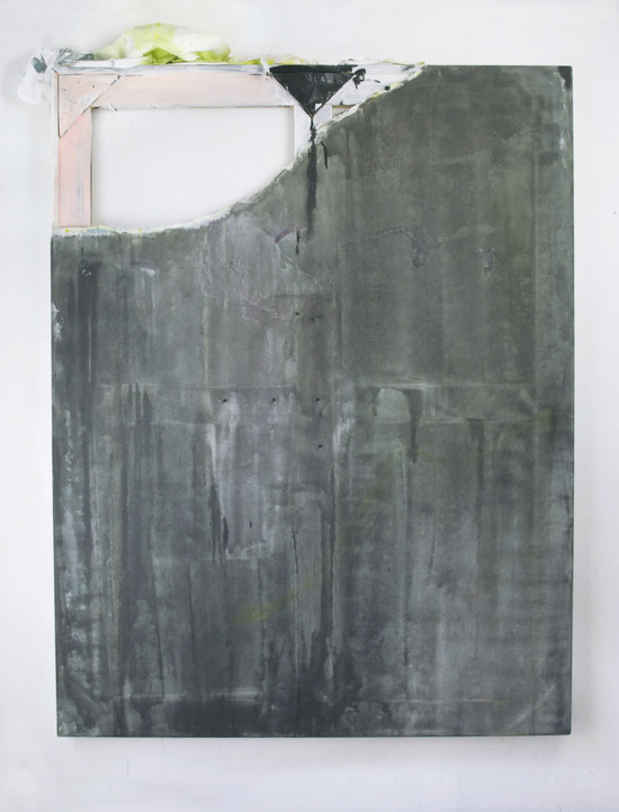Jane Fox Hipple “Corresponding Selves”
DODGEgallery

This event has ended.
DODGEgallery presents Corresponding Selves, an exhibition of new work by painter, Jane Fox Hipple. This is the artist’s third solo exhibition with the gallery.
Known for exhibitions in which one painting—assumed personae—leads into the next, Jane Fox Hipple offers a continuation of this practice in Corresponding Selves, however, she does not simply explore the flow, she also offers contrasting identities. Marked by material interruptions, her canvases, often made of everyday materials—bed sheets, paper towels, sheetrock, explore a new freedom in the acceptance of chance. Hipple controls and alters where possible but ultimately swallows the nature of fate with her tenuous process, further rooting the work in the fallibility of the human condition.
Through stains, protrusions, pinks, leaks, cuts and swells, much of Hipple’s work embraces the erotic mischief of voices like Louis Bourgeois, Eva Hesse, Marcel Duchamp and Walt Whitman. These are works that speak to the body through their physicality. Rothko-esque blankets of calming hues are marred by detritus, screws, gashes and tears, creating a space where beauty and destruction enjoy a tenuous relationship. Disruptive acts give way to a beauty that is fiercer and brighter, closer to the truth. Absence encroaches, under the guise of presence, when an evidence of a slightly different hue suggests that something used to be there in its stead. Slashed fabric reveals the stretcher, itself painted. In Counterparts (Pairs), paper and wood are collaged with an awkward logic, and ultimately usurped by passages of pink and blue that saturate wood and paper with the same application. From skeleton to skin, the entire painting apparatus nourishes a non-hierarchical visual dialogue.
The dictates of the object being painted—how it holds or moves the paint— counters the heavier-handed acts of adding, collaging or applying paint. But the decision to leave something alone is more pivotal than adding or subtracting, as it serves the work and not its author. In pieces such as Self-written (p.s.) and to the test of herself, what could be considered the “picture plane” refuses to politely contain itself within the frames. Although in the language of painting, the practice is about the creation of things. By infringing upon preconceived notions about image and materials, playing with physical distinctions between material forms (both within and around the paintings) and accentuating works as autonomous things through titles and presentation, the works develop autonomous, emotional force.
The inclusion of both decisive action and acceptance of happenstance, leads to works that proffer themselves and weave a dialogue between neighboring pieces, while maintaining their right to stand-alone. It is a visual narrative, divorced of people and specificity. There are, however, two works of this nature that do have a contingent existence: Ring Master and Relief and always on the lookout. The reverb between these married works challenges the position of autonomy that the other pieces claim. Ultimately, the separation of individual works from the practice of painting is the source of disharmony. But in these two instances, while physically separate, the works visually complete each other.
The use of rectangular space in this work parallels the projection of so much content and desire into contained, right-angled forms. The verticality of the works creates uniformity with those around them, the viewer included (presumably). The fabrics in these works are old sheets, suggesting the everyday lived experience, shrouding of the body, passage of time, and the state of unconsciousness (sleep). Once in the service of the human body, the sheets are now of the body of the artwork, transformed through a system of attention and belief. The folding and draping of the fabric visually creates lines and form that integrates into the surrounding wall, while many works have sheetrock (the outer layer of a wall), affixed to their surface. A wall is always a literal and connotative frame, to be taken for granted at varying degrees. The active incorporation of the surrounding wall is paralleled when the paintings visually acknowledge how they were made. For Hipple, the materials dictate the terms of the work as much as creative decision-making. The artwork activates its environment as much as the space around it provides its contour, permitting the works to reach out from the contained space of the rectangle in a self-aware “hello”.
Jane Fox Hipple was born in 1981 in Springfield, Pennsylvania. She received her BFA at Washington University in Saint Louis in 2004 and her MFA from Tulane in 2008. She attended the Skowhegan School of Painting and Sculpture in 2009. Her work as been exhibited at Soho20 Gallery, New York, NY; samsøn, Boston, MA; Daily Operation, Brooklyn, NY; DODGEgallery, New York, NY; the Mills Gallery, Boston Center for the Arts, Boston, MA; Des Lee Gallery, St. Louis, MI; Sardine, Brooklyn, NY; New Art Center, Newton, MA; and Coop Gallery, Nashville, TN. Hipple was the recipient of the 2007 Vermont Studio Center Fellowship Award and the 2010 Somerville Arts Council Fellowship. In 2011, she was an artist in residence at the Ragdale Foundation in Lake Forrest, IL. Her work has been reviewed in Artforum, Timeout New York, New American Paintings Blog, Artcards Review, and The L Magazine, among others. Hipple lives and works in Montgomery, Alabama.
Media
Schedule
from September 14, 2013 to October 27, 2013
Opening Reception on 2013-09-14 from 18:00 to 20:00